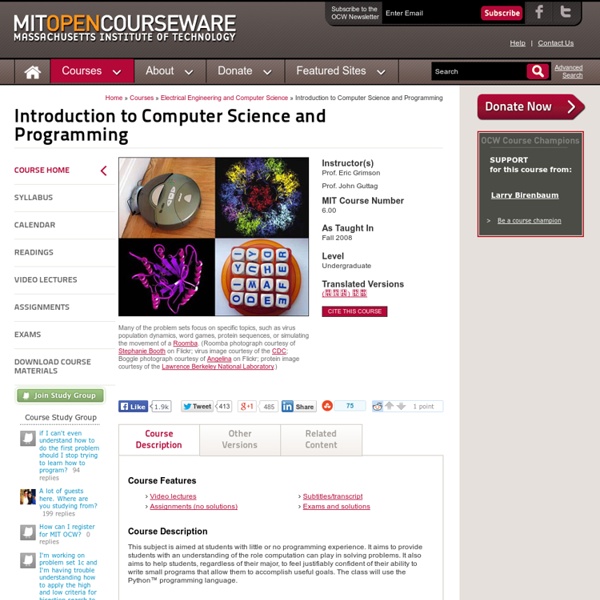



Electrical Engineering and Computer Science | 6.00 Introduction to Computer Science and Programming, Fall 2008 | Video Lectures The most learner-friendly resources about algorithms Dive Into Python Electrical Engineering and Computer Science | 6.00 Introduction to Computer Science and Programming, Fall 2008 | Video Lectures | 1: Introduction and Goals; Data Types, Operators, and Variables MIT OpenCourseWare - Free Courses Python Introduction - Google's Python Class - Google Code Python is a dynamic, interpreted language. Source code does not declare the types of variables or parameters or methods. This makes the code short and flexible, and you lose the compile-time type checking in the source code. An excellent way to see how Python code works is to run the Python interpreter and type code right into it. $ python ## Run the Python interpreterPython 2.7.1 (r271:86832, Jul 31 2011, 19:30:53) [GCC 4.2.1 (Based on Apple Inc. build 5658) (LLVM build 2335.15.00)] on darwinType "help", "copyright", "credits" or "license" for more information.>>> a = 6 ## set a variable in this interpreter session >>> a ## entering an expression prints its value6>>> a + 28>>> a = 'hi' ## a can hold a string just as well>>> a 'hi'>>> len(a) ## call the len() function on a string2>>> foo(a) ## try something that doesn't workTraceback (most recent call last): File " Python Program Python source files use the ".py" extension. #! Running this program from the command line looks like:
Developing Digital Design Techniques (doctoral thesis) Doctoral Thesis 2005 Download full thesis here >>>>> Abstract Industrial designers, architects, graphical designers and others have slowly adapted to the new digital design tools. This thesis documents and develops a long-term exploration of a special type of design, the digital design that appeared during the nineties and that possibly started with the animation techniques introduced by Greg Lynn and the experimental use of diagrams introduced by Peter Eisenman. This thesis, focuses on the early stages of the design process; the explorative phases before the constrains of realisation start to narrow down the options. A central aspect of creative design computing is the generative potential in digital technology. - Human creativity of all kinds and in all variations: individual, social, cultural. - The design media: the design concepts, tools and technologies that are available (from pencil to computational photorealism, complex simulations and emergence).
WiBit.net: Introduction to Computer Programming This is our fundamentals course! Software development is not all glamorous. There are many underlying concepts that lay beneath the code that are important to understand in order to reach your full potential. The WiBit.Net training method focuses on basics. Why? Well, for a simple reason. All this learning begins here with Introduction to Computer Programming.